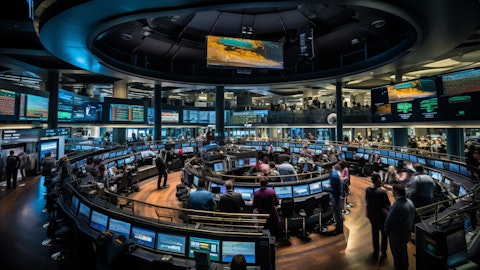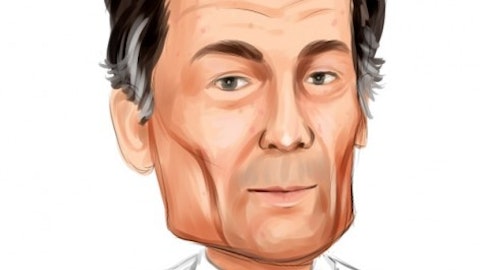It’s up 50% so far this year, and the buy-side clients was up 50% last year and 80% this year. So, it’s a global story. It’s a story that’s being adopted by buy-side and commercial participants, and it’s a global story for us. I think the last piece of that is the central role that options continues to play in markets as volatile as we have seen in natural gas. Options are the optimal tool for the way customers interact with this business. So, when we look at our nat gas options, this has set a record last year of over 150,000 contracts, up over 40%, and the vast proportion of that was on screen. And 2024 has started extremely strong with almost 300,000 contracts so far a day, and nat gas options up over 100%. So, overall, it’s a globalized story.
It’s one where we continue to engage and one that’s real to our story.
Terry Duffy: Ken, hopefully that gives you a little bit of color on the energy markets in the Gulf Coast and other places.
Ken Worthington: That was excellent. Thank you.
Terry Duffy: Thanks, Ken.
Operator: Next question is coming from the line of Brian Bedell with Deutsche Bank. Please go ahead.
Brian Bedell: Great. Thanks. Good morning, folks. Thanks for taking my question. If I could just ask a two-parter, just one on a — little bit of a clarification on the market data price increase that’s coming into that 2.5% to 3%. If I back out the collateral increase from [7% to 10%] (ph), it looks like the market data increase is maybe less than the increase for the RPC. I just wanted to gauge that. And then just secondarily, maybe just if you can talk about the development of incremental trading volume from the [DTC] (ph) arrangement, just your views on to what extent that capacity increase for the clients will make its way into more trading volume and the rates come up.
Terry Duffy: Okay. Thanks, Brian. Lynne will touch on the data as the market data pricing changes that you referenced. And then I’ll have Tim McCourt and probably myself touch a little bit on the trading volume as it relates to DTCC and the arrangement associated with it. Lynne?
Lynne Fitzpatrick: Yeah. So the pricing changes that went into market data were in the range of 3% to 5% across the majority of our data products. The total impact is going to come down to the subscriber count, the customer and product mix, just like we see on the transaction side. But most of the products went up in that 3% to 5% range.
Terry Duffy: Does that get to your question on the data, Brian?
Brian Bedell: Yes, that answers that. Thank you.
Terry Duffy: Okay, so on the trade volume question that you had is relates to the DTCC arrangement, is that the second part?
Brian Bedell: Yes. In terms of your expectations for volume improvement, given the capacity improvement from the client base that’s trading and rate interest.
Terry Duffy: We’re always cautious on expectations, but let me go ahead and have Tim start a little bit with the client base on how they’re reacting to it. And I think you got a little bit of a flavor for it on the previous answer that Ms. Sprague gave as it relates to the clients that are using it already getting the 75% to 80% efficiencies with their margin portfolios. But Tim, let me turn to you for some comment.
Tim McCourt: Thanks, Terry, and thanks, Brian. As Terry said, it’s very difficult, almost impossible to forecast the impact on trading volumes going forward. But if we look back over the years, increasing capital savings and delivering capital efficiencies to clients has been a strong tailwind for our business in terms of increasing the ability of our clients to manage risk at CME by unlocking those capital efficiencies. And if we look at an analog, perhaps, is when we look at the portfolio margin savings or our futures and options conflicts against the cleared interest rate swap business, that has grown over the last several years to about $7 billion to $8 billion of savings per day. And we’ve seen commensurate growth in volume NOIs. Hard to draw a strict relationship, but tried and true is increasing capital efficiencies, increase the ability of our clients to efficiently manage their risk, provide enormous volume benefits in terms of the offsets available, and we’ll continue to watch it developing, but hard to give an exact number at this point in time.
Terry Duffy: And Brian, the only thing I would add to that, you have to look at what we talked about earlier today, and you see the entire 2023, especially going into the end of Q3 and the beginning of Q4 of 2023. We saw the record open interest in our treasury complex across the curve, which is very encouraging for us. So, from our standpoint, owning a cash platform and owning the largest listed business in the world, this is very exciting for us. We’ve talked all along about futurization of products. You’re seeing that more and more every single day, the electronification of different products. And with the growth in our rates business going into last year, I think was just another example that with the record open interest in trade coming into our treasury complex.
So, from the growth, it’s hard to say what the growth is coming from or what’s driving it, but by owning both platforms, we get the benefits either way, and we saw the benefits really materialize on the future side in 2023, especially in Q4.
Brian Bedell: That’s great perspective. Thank you.
Terry Duffy: Thank you.
Operator: Our next question is coming from the line of Benjamin Budish with Barclays. Please go ahead.
Benjamin Budish: Hi. Good morning, and thanks for taking the question. Terry, in your prepared remarks, you talked about expanding end-user client participation. I was wondering if you could expand upon that a little bit, both in the energy complex. And on the rate side — on the rate side, are you seeing sort of more activity from your existing client base? Are you seeing more participation from maybe new institutions that are increasingly engaging in the sort of risk management behavior? Yeah, thank you.
Terry Duffy: Yeah, thanks, Benjamin. And I’ll start with the rates just for a minute, and my colleagues can jump in if they’d like, especially Julie Winkler, who’s in charge of our new client acquisition. But on the rate side, I think a lot of it goes to what I just said on the futurization of the marketplace and people trading more and more futures contracts versus maybe particular other venues. And that’s an ebb and flow situation. So I’m not saying it’s going to continue at the pace it continued in ’23, and I’m not saying it’s not either, though. So I like the way the trajectory is. And I think a lot of the clients, when you look at what happened with the duration risk through 2023 for a lot of different participants, they are now looking at using the marketplace, which are most deep liquid markets, which are ours, to mitigate and manage that risk.
So I think we’re seeing it from them. As you know, the direct clients, we can see, but some of them are coming through our major banks, so we don’t know exactly who the client is to the person or the entity. But you can definitely see that people are looking at the fundamentals that are going on around the world and using our marketplace to use it. So I think that’s part of the new clients. On the energy side, I think when you look at the new clients, I think you’d have to be exceptionally excited by the commercial energy participants that Derek referenced, especially in the Gulf Coast contracts. We’re looking at close to 80 different commercial participants that are trading in those Argus contracts that we referenced earlier. So that’s a growth for us on the energy side.
So this is all part of it. So we’re not just looking at retail or other proprietary trading. We’re looking at true commercial participation, which is a reflection of the health of anyone’s marketplace. So I think that’s what’s really exciting for us as we look at the new clients coming into our marketplace. And I’ll ask my colleague, Ms. Winkler, to make some further comments.
Julie Winkler: Yeah. I think Terry is absolutely right. And the two segments that I would just hone in on, Benjamin, that we saw particularly double-digit growth from last year was really the buy side and the commodities, or sorry, the commercial segment as well. And so when we look at that, we saw really strong ADV from asset managers, again, double-digit, the [semi-buy] (ph) side clients that really are looking at our products because of the regulatory environment, the liquidity, and also the capital efficiencies that we offer. And so the products that I’d say they were most interested in and what we saw, almost half of that growth was coming from interest rates with all of the volatility and movement that we saw last year, but also a lot of interest in our commodity suite.
So hedge funds, managed funds that are really looking at CME’s agricultural portfolio, and also more esoteric products, things that we offer like milk and lumber, because they’re looking to diversify the risk profiles and also access those uncorrelated markets. And so it’s another sign of our really diverse product portfolio, meeting customer needs. On the commercial side, double-digit growth, both in terms of revenue and ADV last year. And that was really as they were looking to hedge their physical positions, manage that risk exposure, saw good uptake in some of our new industrial metals, the energy companies that we talked about before. And I think this trend speaks to the transparency, the efficiencies, and the well-regulated futures markets that we offer.
And then internationally, I think, particularly in Europe, on the short-term interest rate side, we saw some really strong performance and also interest across our commodities and FX suite. So I think we have a lot to build on as we look into 2024, but very strong performance in those areas last year.
Terry Duffy: Thanks, Julie. And, Benjamin, let me end on this note as it relates to that. I think it’s really important and we don’t state it enough. As it relates to our rates business, especially, you look at some of the largest participants who I referenced earlier, between their activity in swaps and futures, and futures is a critically important point here, they’re saving roughly $7 billion to $8 billion a day in margin efficiencies where they could deploy that capital in other activities, whether it’s trading other parts of their business. That’s hard to replicate. And that’s a benefit to the largest clients in the world that can use that money to be deployed elsewhere. So that has grown substantially since 2015. So that’s been a big growth driver for us over the last 8.5 to nine years as well.



